Services on Demand
Article
Indicators
Related links
-
 Cited by Google
Cited by Google -
 Similars in Google
Similars in Google
Share
South African Journal of Education
On-line version ISSN 2076-3433
Print version ISSN 0256-0100
S. Afr. j. educ. vol.30 n.3 Pretoria Jan. 2010
ARTICLES
Teachers' beliefs and their intention to use interactive simulations in their classrooms
Jeanne KriekI; Gerrit Stols
ABSTRACT
In this pilot study, we sought to examine the influence of the beliefs of Grade 10 to 12 physical science teachers on their intended and actual usage of interactive simulations (Physics Education Technology, or PhET) in their classrooms. A combination of the Theory of Planned Behaviour, the Technology Acceptance Model and the Innovation Diffusion Theory was used to examine the influence of teachers' attitudes, subjective norms and perceived behavioural control on their intention to use simulations in their classrooms. Using regression and factor analyses, it was found that beliefs about the perceived usefulness and the pedagogical compatibility of PhET have a significant effect on teachers' attitude towards the use of the simulations in their classrooms. The expectations of the teachers' colleagues contribute to the subjective norm of these teachers. The regression and partial correlation result also highlights the importance of teachers' general technology proficiency. Although we were not able to confirm a direct link between attitudes, subjective norm, perceived behavioural control, and the teachers' behaviour intention we show the influence of behaviour intention on the actual use of the simulations with an accuracy of 70.83%.
Keywords: interactive simulations; PhET project; physics; teacher beliefs; Theory of Planned Behaviour
Introduction
Technology can be used to strengthen student learning and enhance pedagogy (Dede, 2000) and can be used effectively as a cognitive tool for teaching and learning in the classroom (Bruce & Levin, 2001; Bransford, Brown & Cocking, 2000). Researchers agree that students using a computer to prepare for laboratories make greater conceptual gains, and are more capable of integrating knowledge, than those who use the textbook and solve additional problems on the topic (Zacharia & Anderson, 2003; Linn & Hsi, 2000; Linn, Eylon & Davis, 2004; Triona & Klahr, 2003). In the context of developing countries, information and communication technology (ICT) has the potential and capacity to overcome barriers such as equity and redress (Department of Education, 2003). Therefore, in order to be competitive with the rest of the world, the South African government positioned itself by drafting a White paper on e-Education (Department of Education, 2003) which provided the implementation strategies (three phases) of how ICT will be incorporated in the learning, teaching and administration of all schools in South Africa. As experienced when the National Curriculum Statement was implemented, teachers' beliefs can make or break the implementation of an innovation, and must be aligned to the spirit of the innovation. Therefore, in order to implement ICT in teaching and learning we need a better understanding of the beliefs that influence teachers in deciding to use technology or not.
Cuban (2001) warns that explaining teachers' behaviour in using or not using technology needs to go beyond popular explanations that tend to blame teachers. Research explains how and why individuals adopt new information technologies (Venkatesh, Morris, Davis & Davis, 2003), but it is not known what influences teachers to use technology in their classroom; we need a better understanding of the beliefs that inform these decisions.
Hew and Brush (2007), Nyaumwe (2006), and Albion (2001) have identified teachers' attitudes and beliefs as barriers to using technology for instruction. Problems can emerge when teachers' beliefs are ignored, because "beliefs and values that teachers hold drive many of the choices they make in the classroom" (Cuban, 2001:169). Cuban (op.cit.) argues that beliefs influence what and how teachers choose to teach and what innovations they endorse or reject. In addition, "teachers' beliefs and principles are contextually significant to the implementation of innovations" (Munby, 1984:28). We therefore need a deeper understanding of the nature of beliefs that influence teachers' behaviour and how these beliefs are manifested.
Context
This pilot study focuses on the use of interactive physics simulations by teachers in their physical science classrooms. Finkelstein, Adams, Keller, Kohl, Perkins, Podolefsky, Reid & LeMaster found that "properly designed simulations used in the right contexts can be more effective educational tools than real laboratory equipment, both in developing student facility with real equipment and at fostering student conceptual understanding" (2005:1). By integrating modelling and visualisation as opposed to traditional teaching methods, the difficulties in physical science concepts can be overcome (Gilbert, Justi & Aksela, 2003). Interactive simulations are a new way to transfer scientific ideas and connect students in educational activities (Perkins, Adams, Dubson, Finkelstein, Reid, Wieman & LeMaster, 2006; Linn, Eylon & Davis, 2004).
With this in mind, we introduced interactive physics simulations software, Physics Education Technology (PhET), to physical science teachers. These simulations are freely available on the internet and therefore accessible to all South Africans. PhET was developed by a group of researchers from the University of Colorado at Boulder in the USA and is grounded in research on how students learn and their conceptual difficulties and misconceptions. The PhET project's goals are "increased student engagement, improved learning and improved beliefs about and approach toward learning" (Wieman, Perkins & Adams, 2008:394). The PhET simulations are highly interactive and provide animated feedback to the user. In developing the simulations, researchers made use of "student interviews and classroom testing to explore issues of usability, interpretation and learning" (Wieman et al., 2008:394).
The purpose of this study is to identify the beliefs that may influence teachers' decision to use PhET in their classrooms. This research used the Circuit Construction Kit from the PhET interactive simulations. The Circuit Construction Kit was selected for the following reasons:
• the possibility of addressing misconceptions held about electric circuits
• the visual representation of electron flow
• the possibility of varying the resistance and/or potential difference (Finkelstein et al., 2005).
Theoretical framework
Various models exist for trying to predict and explain human behaviour. The Theory of Planned Behaviour (TPB) explains human behaviour in general settings. To elucidate and explain behavioural beliefs in the context of information technology, models of the adoption of technology innovations were investigated. Information technology researchers have developed models for studying the software utilisation choices of users; for example, the Technology Acceptance Model (TAM) and the Innovation Diffusion Theory (IDT). The latter models can also be used to clarify behavioural beliefs in the context of the use of technology for teaching, and all three models will be discussed.
Theory of Planned Behaviour
TPB explains human action and suggests that it is guided by behavioural, normative and control beliefs (Figure 1).
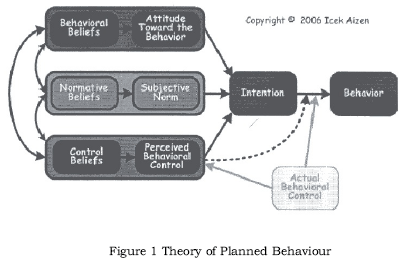
Ajzen (1991) explains that behavioural beliefs are beliefs about the probable outcomes of behaviour and the corresponding judgments about these outcomes, while normative beliefs are about the expectations of other people and the motivation to comply with their expectations. Control beliefs include beliefs about both internal and external factors that may facilitate or impede performance of behaviour. Internal factors include skills, abilities and emotions, while external factors include environmental factors such as beliefs about infrastructure, support staff and access to computers. Together, these factors will determine the behavioural intention, and hence in the end also the behaviour, given a sufficient degree of the individual's actual control over the behaviour.
Technology Acceptance Model
In 1992 Bagozzi, Davis and Warshaw adapted the Theory of Reasoned Action to develop the TAM, as an attempt to explain factors that influence users' acceptance of information technology systems (Bagozzi, Davis & Warshaw, 1992). TAM currently enjoys the status of being the prime tool for testing user acceptance of new technologies (Green, 2005). This model ignores the role of normative beliefs and control beliefs and replaces behavioural beliefs about the outcome with only two beliefs - perceived ease of use and perceived usefulness (Figure 2). Perceived usefulness is about the extent "to which a person believes that using the system will enhance his or her job performance", while perceived ease of use is about "a person's beliefs that using the specific technology will be free of effort" (Davis, 1989:320).

Several researchers have replicated Davis's research and found perceived usefulness to be a strong determinant of user intentions:
Numerous empirical studies have found that TAM consistently explains a substantial proportion of the variance (typically about 40%) in usage intentions and behaviour... In 10 years, TAM has become well-established as a robust, powerful, and parsimonious model for predicting user acceptance (Venkatesh & Davis, 2000:186).
This model is much simpler than TPB, and proved to be useful in explaining technology adaption of software (Venkatesh & Davis, 2000). A correlation coefficient (r) of 0.54 between behaviour intention and actual use was found within the field of consumer behaviour (Sheppard, Hartwick & Warsaw 1988). Currently TAM is a well-established model and is widely accepted among researchers in the field of information technology (Ahmad, Madarsha, Zainuddin, Ismail & Nordin, 2010).
Innovation Diffusion Theory
IDT is used to study a variety of innovations (Rogers, 2003). One of the main differences from TAM is the addition of a factor that Rogers calls compatibility. According to Ahmad et al. (2010:271), IDT "explains technology adoption as a process taking place over time". This model explains that technology adoption is dependent on five key factors: the relative advantage, the complexity of the innovation, the compatibility, the trialability and observability. According to Moore and Benbasat (1991:195), relative advantage is about "the degree to which an innovation is perceived as being better than its precursor", while complexity is "the degree to which an innovation is perceived as being difficult to use". Compatibility is "the degree to which an innovation is perceived as being consistent with the existing values, needs, and past experiences of potential adopters". These factors have been addressed in TPB and TAM. For this study trialability, which is about availability, has been addressed by TPB's control beliefs, and because of the nature of using interactive simulations, observability has been included in "relative advantage". Neither TAM nor TPB addressed the component "compatibility" of the technology with the existing values and experiences of potential users, and was therefore included as an extra component to our model.
Combining the Theory of Planned Behaviour, the Technology Acceptance Model and the Innovation Diffusion Theory
A close similarity exists between the variables in TAM and IDT: the relative advantage in IDT is related to the perceived usefulness in TAM, while the complexity of IDT is related to the perceived ease of use of TAM. Perceived compatibility has been added from IDT, and therefore the combined model postulates that attitudes are influenced by perceived usefulness, perceived ease of use, and the perceived compatibility.
The subjective norm in TPB is "the person's perception that most people who are important to him think he should or should not perform the behaviour in question" (Fishbein & Ajzen, 1975:302, Knowles, Nieuwenhuis & Smit, 2009). In a teaching context, the people who could influence teachers' normative beliefs are typically the principal, learners, parents and colleagues. Perceived behaviour control is influenced by individuals' control beliefs. According to McCabe (2004:503), control beliefs are a function of both external and internal control beliefs: "Thus intention to behave is a function of perceived internal control (i.e. confidence in skills and abilities) and behaviour is a function of external control (i.e. opportunity and resources available)". In this study, the internal control beliefs are about the teachers' general technology proficiency, while the external control beliefs are about the availability of the IT infrastructure.
Combining the three models results in a new model (see Figure 3) which will be referred to as the Combined Model and has the potential to improve our understanding of technology used by teachers in general, and also in their classrooms for instruction. This Combined Model will be used as a framework for analysing teachers' use of interactive simulations in their classrooms.
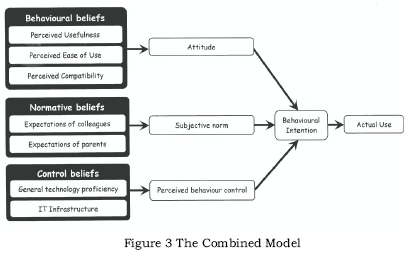
Similarly, Venkatesh et al. (2003) reviewed eight user acceptance models and then developed the Unified Theory of Acceptance and Use of Technology. Their research model proposes that Performance Expectancy (perceived usefulness), Effort Expectancy (perceived ease of use), Social Influence (subjective norm) and Facilitation Conditions (control beliefs) have an influence on actual use. All these determinants have been addressed in the Combined Model.
Research aim
The aim of this research was threefold. The first objective was to examine the influence of Grade 10 to 12 (16-18 years) physical science teachers' behavioural beliefs, normative beliefs and control beliefs on their attitudes, subjective norm and perceived behaviour control respectively. The second objective was to determine the impact of teachers' attitudes, subjective norm and perceived behaviour control on their intention to use PhET in their classrooms. Finally, their actual usage was compared with their intention to use PhET.
Research design
The first step in this research was to examine publications to identify possible salient beliefs of teachers regarding the use of educational software. Stols (2008) reviewed 53 publications that were selected for their relevance. From the publications, he clustered factors influencing attitude, subjective norm and perceived behaviour control. In the case of attitudes, the following salient beliefs were identified: pedagogical compatibility of the technology, perceived ease of use of the technology and its perceived usefulness. The beliefs influencing subjective norm were normative beliefs about colleagues, learners, the principal and parents. Finally, perceived behaviour control was influenced by internal control beliefs such as belief in one's own general technology proficiency and software skills, while external control beliefs referred to such aspects as infrastructure, IT support staff and access to technology or an IT lab.
In this pilot study an experimental design was used to investigate the relationship between the above-mentioned constructs. The study was conducted as a pilot for a more comprehensive study. Both correlation and regression techniques were used to examine these relationships. The correlation statistics were used to find the correlation between the beliefs and their respective direct measures of the constructs in Figure 3. For example, correlation was found between the beliefs about usefulness, ease of use, and compatibility of using PhET with the attitudes towards the use of the interactive simulations. By using stepwise regression analysis it was possible to identify the weights of the attitudes, subjective norm and perceived behaviour control on the intention to use PhET. The intention was then compared with the actual usage by using descriptive statistics. Because of the small sample size, the study also employed a structural equation modelling technique, in this case confirmatory factor analysis from partial least squares (PLS).
Participants and procedure
The study was carried out in South Africa, using a representative sample of teachers from both semi-urban and urban schools. This sample consisted of seven high school teachers from semi-urban areas and 17 from urban schools. Data were obtained from these 24 (10 male and 14 female) teachers, who represented a variety of cultures. Their average teaching experience was 13 years and their average age 39.46 years. All teachers participating in the study were physical science teachers, teaching Grades 10 to 12. All participants voluntarily agreed to participate in this study. Follow-up interviews were conducted with the teachers three months after the workshops.
Questionnaire
The questionnaire was designed by the authors using the guidelines set by Francis, Eccles, Johnston, Walker, Grimshaw, Foy, Kaner, Smith and Bonetti (2004). The first step in the design of the instrument was to conduct an elicitation study to elicit commonly held beliefs about the use of interactive simulations for teaching. The questionnaire consisted of 132 questions. The following is an example of a question designed to determine the behaviour belief-perceived usefulness: "The use of PhET will make it easier for the learners to visualise electric circuits".
A 7-point Likert scale was used for all the questions, varying from "extremely unlikely" to "extremely likely", or "definitely false" to "definitely true".
Workshop
Teachers must know and understand the advantages, limitations and functions of the simulations to be able to know what their beliefs about them are. Therefore, the first author conducted a three-hour workshop one day a week for three consecutive weeks on the use of PhET in the physical science classroom before the teachers completed the questionnaire.
The workshop focused on the Circuit Construction Kit from the PhET project. This simulation kit allows the user to construct electric circuits with any number of batteries, bulbs, resistors and wires in any combination. Potential differences and electric currents can be measured by simulated voltmeters and ammeters (see example in Figure 4).
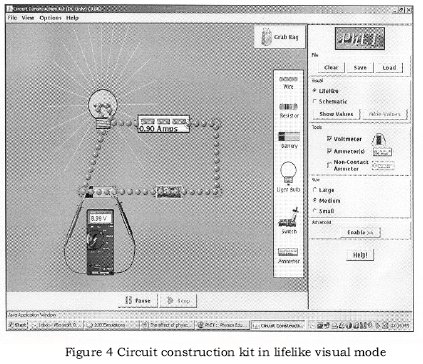
Results
Table 1 presents a summary of the responses to the questionnaire about the different categories and constructs of the Combined Model. Each category will be discussed separately.
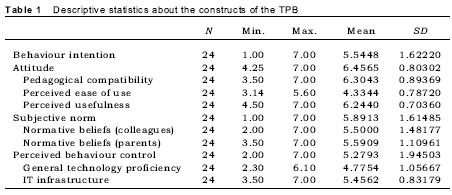
Influence of behavioural beliefs on attitude
According to the Combined Model, behavioural beliefs will produce a positive or negative attitude towards the behaviour. Behavioural beliefs include beliefs about the perceived usefulness, perceived ease of use, and pedagogical compatibility of using interactive simulations with current instructional practices. In the following tables, (**) indicates significance at the 0.01 level (two-tailed) and (*) significance at the 0.05 level (two-tailed).
Table 2 shows that both perceived usefulness and pedagogical compatibility correlate significantly with attitudes. PLS were used to determine the reliability regression or path analysis; this is a predictive technique that can handle many independent variables.
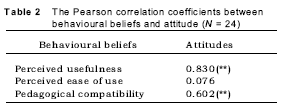
In Table 3, the model effect loadings for prediction of perceived usefulness, perceived ease of use and pedagogical compatibility on attitudes were 0.807, 0.074 and 0.585, respectively. It can be concluded that only beliefs about perceived usefulness and pedagogical compatibility influence attitudes, and therefore this result is highly consistent with the results from the regression analyses and correlation statistics.
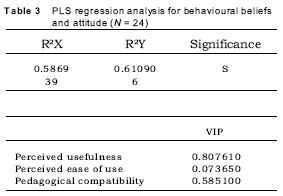
Influence of normative beliefs on subjective norm
Normative beliefs are the perceived behavioural expectations of important individuals, leaders, groups or colleagues. Judging from the literature in a teaching context, these would typically be colleagues, learners, parents and the principal. TBP assumes that these normative beliefs, in combination with the person's motivation to comply with them, determine the subjective norm.
Table 4 shows that the correlation coefficient of 0.577 between subjective norm and normative beliefs (colleagues) is significant at the 0.01 level of significance and 0.475 between subjective norm and normative beliefs (parents) is significant at the 0.10 level of significance only. These results are confirmed by the PLS analyses.

From tables 4 and 5 it is clear that the expectations of colleagues and parents did have a significant impact on the subjective norm of these teachers. This significant impact was also confirmed by the factor analysis of PLS.
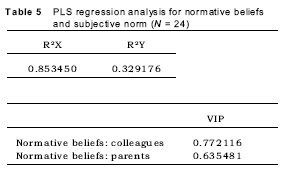
Influence of control beliefs on perceived behavioural control
Perceived behavioural control is about the presence of factors that may facilitate or impede performance of the behaviour, and the perceived power of these factors (Ajzen, 1991). In the context of this article, perceived behavioural control relates to factors influencing the extent to which teachers feel able to use PhET in the classroom. Control beliefs include both internal and external factors. Internal control beliefs include the teacher's perception of his or her general technology proficiency, while the external control beliefs are about the availability of the IT infrastructure.
Table 6 indicates that the general technology proficiency of the teacher relates to perceived behavioural control. The participating teachers did not see IT infrastructure as a significant barrier. A positive significant correlation of 0.534 was found between perceived behavioural control and the general technology proficiency of the teachers. This is understandable, as these simulations were developed as a tool for conceptual understanding and are easy to use. This impact was also confirmed by the factor analysis of PLS shown in Table 7.

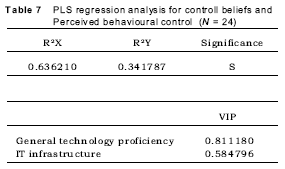
The PLS model effect loadings for general technology proficiency and IT infrastructure on perceived behavioural control were 0.811 and 0.584, respectively. The regression and partial correlation results suggest that general technology proficiency and IT infrastructure mediate the effect of perceived behavioural control.
Influence of attitude, subjective norm and perceived behavioural control on behaviour intention
The intention of teachers to use PhET in their classrooms is based on attitude toward the use of PhET, the subjective norm and the perceived behavioural control. Each of these three predictors was weighted for its importance in relation to the teachers' intention to use PhET in their classrooms, as shown in Table 8.

The values in Table 9 confirm the findings shown in Table 8, namely, that no significant positive correlation was found between the behavioural intention and attitude, the subjective norm and the perceived behavioural control.
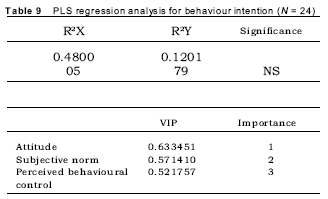
Actual use in the classroom
Three months after the workshop, we followed up on the technology implementation of all the teachers (100%). According to the Combined Model, the actual usage of interactive simulations will be influenced by their behaviour intention. Therefore we compared the average score of the six questions in the questionnaire that were posed to determine the behaviour intention with the teachers' actual use of interactive simulations in their classrooms. Using the average score for these questions regarding behavioural intention, we regarded a score of higher than 4 on the 7-point Likert scale as an indication of a respectable intention to use interactive simulations (see Table 10).
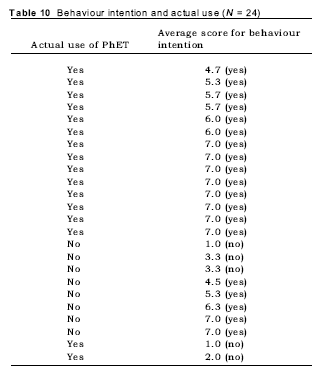
From the questionnaire and interviews, 14 teachers indicated that they intended to use PhET in their classrooms and did in fact do so (Table 10). Three teachers had no intention of using PhET, and did not use it in their classrooms. Five teachers (21%) indicated that they were going to use simulations but did not use them. Only 2 (8%) teachers who did not intend using PhET used it in the end. This model therefore predicted with a 70.83% accuracy the teachers' intention and actual behaviour.
Discussion
Technology can be used to strengthen student learning, but it is rarely used in physical science classrooms. In order to implement ICT in teaching and learning we need a better understanding of the beliefs that influence teachers' use of technology. TPB proposes that people's behavioural beliefs, normative beliefs and control beliefs have an effect on their attitude, subjective norm, and perceived behavioural control respectively. This theory, in combination with TAM and IDT, resulted in the Combined Model (see Figure 5), which has the potential to improve our understanding of technology use by teachers.
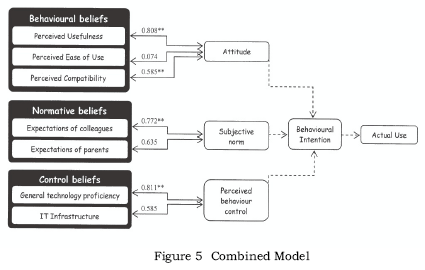
This model was used as the framework for analysing teachers' use of interactive simulations in their classrooms. It was found that in the context of teachers using PhET in their classrooms, beliefs about perceived usefulness and perceived compatibility influenced the teachers' attitude towards using the simulations in their classrooms. The expectations of colleagues did have a significant impact on the subjective norm of these teachers. The regression and partial correlation results suggest that general technology proficiency and IT infrastructure mediate the effect of perceived behaviour control. Comparing behavioural intention with the teachers' actual usage, this model predicted the teachers' intention and actual behaviour with 70.83% accuracy.
When IT infrastructure was available and sufficient, it did not constitute a barrier to using PhET, but the absence or insufficiency of infrastructure posed an insurmountable barrier to using this technology. According to TPB, the intention of teachers to use PhET in their classrooms is based on attitude toward the use of PhET, the subjective norm and the perceived behavioural control. This pilot study found that teachers' behavioural beliefs about perceived usefulness and compatibility influence their attitude towards the use of PhET in their classrooms.
In further analyses it was found that general technology proficiency combined with normative beliefs of colleagues explains 64.8% of the use of PhET by these teachers. These results suggest a simplification of the original model shown in Figure 3.
This Simplified Model (see Figure 6) sufficiently explains the use of PhET in their classrooms by 17 (70.83%) of the 24 teachers. Fourteen indicated up-front that they would use it and did, while three indicated upfront that they would not use it and they did not change their behaviour. Two teachers indicated that they would not use PhET but did use it in the end.
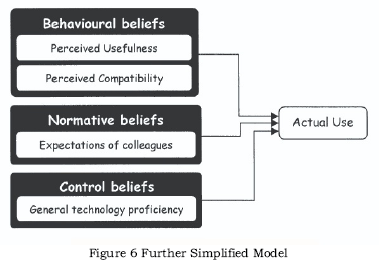
Interviews were conducted with the teachers to investigate possible reasons why they did not in the end use PhET in their classrooms, or initially indicated that they did not intend using PhET but did use it subsequently. The reasons were that when they had to teach "electric circuits" they decided to use PhET in the classroom, and they used it whenever they started a new section because it helped the learners to visualise the concepts.
The fact that five of the 24 teachers who intended to use PhET did not use it was contradictory to the projection of TPB. In interviews they indicated that access to computers was the only reason for not using PhET in the classroom. This suggests that there is a relationship between IT infrastructure and perceived behaviour control, which was found to be insignificant "regression analysis". In a study to determine 533 teachers' beliefs about using educational technology in the science classroom, it was found that, where classroom structures that support use of technology are needed, support structures are also needed before teachers can use the technology (Czerniak, Lumpe, Haney & Beck, 1999).
Conclusion
In order to answer the question "Why don't physical science teachers use technology, in this case interactive simulations, in their classrooms?", we need a better understanding of the beliefs that influence teachers to decide to use this technology or not. The first aim was to examine the influence of physical science teachers' behavioural beliefs, normative beliefs and control beliefs on their attitudes, subjective norm and perceived behaviour control respectively. This pilot study found that these teachers' behavioural, normative and control beliefs influenced their actual behaviour. The second objective of the study was to determine the impact of teachers' attitudes, subjective norm and perceived behaviour control on their intention to use PhET in their classrooms. This study did not confirm this relationship. Finally, their actual usage was compared with their intention to use PhET. This model predicted the actual usage with 70.83% accuracy.
These preliminary findings will be able to focus the attention of district officials on what aspects they will have to consider if they want teachers to use PhET in their classrooms. In order to promote the use of interactive simulations, they must be exposed to PhET to experience its usefulness in science teaching. To use the normative beliefs, this exposure must be done in groups with colleagues and teachers must have basic computer proficiency.
Acknowledgements
Funding for this research was provided by the National Research Foundation of South Africa. We thank the teachers of the Tshwane North and South districts for their participation and contributions and Prof Francois Steffens from the University of Pretoria for doing the statistical analyses of the data.
References
Ahmad TBT, Madarsha KB, Zainuddin AM, Ismail NAH & Nordin MS 2010. Faculty's acceptance of computer based technology: Cross-validation of an extended model. Australasian Journal of Educational Technology, 26:268-279. Available at: http://www.ascilite.org.au/ajet/ajet.html, accessed on 01/05/2010. [ Links ]
Ajzen I 1991. The theory of planned behaviour. Organizational Behavior and Human Decision Processes, 50:179-211. [ Links ]
Albion PR 2001. Some factors in the development of self-efficacy beliefs for computer use among teacher education students. Journal of Technology and Teacher Education, 9:321-347. [ Links ]
Bagozzi RP, Davis FD & Warshaw PR 1992. Development and test of a theory of technological learning and usage. Human Relations, 45:660-686. [ Links ]
Bransford JD, Brown AL & Cocking RR 2000. How people learn: brain, mind, experience, and school. Washington, DC: National Academy Press. [ Links ]
Bruce B & Levin J 2001. Roles for new technologies in language arts: inquiry, communication, construction, and expression. In: J Jenson, J Flood, D Lapp & J Squire. The handbook for research on teaching the language arts. New York: Macmillan. [ Links ]
Cuban L 2001. Oversold and underused computers in the classroom. London: Harvard University Press. [ Links ]
Czerniak CM, Lumpe AT, Haney JJ & Beck J 1999. Teachers' Beliefs about Using Educational Technology in the Science Classroom. International Journal of Educational Technology, 1:1-18. [ Links ]
Davis FD 1989. Perceived usefulness, perceived ease of use, and user acceptance of information technology. MIS Quarterly, 13:319-340. [ Links ]
Dede C 2000. Emerging influences of information technology on school curriculum. Journal of Curriculum Studies, 32:281-303. [ Links ]
Department of Education 2003. White paper on e-Education. Pretoria: Department of Education. [ Links ]
Finkelstein ND, Adams WK, Keller CJ, Kohl PB, Perkins KK, Podolefsky NS, Reid S & LeMaster R 2005. When learning about the real world is better done virtually: A study of substituting computer simulations for laboratory equipment. Phys. Rev. ST Phys. Educ. Res. 10:10-103. [ Links ]
Fishbein M & Ajzen I 1975. Belief, attitude, intention, and behavior: an introduction to theory and research. Reading, MA: Addison-Wesley. [ Links ]
Francis JJ, Eccles MP, Johnston M, Walker A, Grimshaw J, Foy R, Kaner EFS, Smith L & Bonetti D 2004. Constructing questionnaires based on the Theory of Planned Behaviour: a manual for health services researchers. Available at: people.umass.edu/.../Francis%20etal.TPB%20research%20manual.pdf, ccessed 30/09/09. [ Links ]
Gilbert JK, Justi R & Aksela M 2003. The visualisation of models: a metacognitive competence in the learning of chemistry. Paper presented at the 4th European Science Education Research Association, Noordwijkerhout. [ Links ]
Green IFR 2005. The emancipatory potential of a new information system and its effect on technology acceptance. Unpublished PhD thesis. Pretoria: University of Pretoria. [ Links ]
Hew KF & Brush T 2007. Integrating technology into K-12 teaching and learning: current knowledge gaps and recommendations for future research. Educational Technology Research and Development, 55:223-252. [ Links ]
Knowles M, Nieuwenhuis J & Smit B 2009. A narrative analysis of educators' lived experiences of motherhood and teaching. South African Journal of Education, 29:333-343. [ Links ]
Linn M & Hsi S 2000. Computers, teachers, peers: Science Learning Partners. Mahwah, NJ: Erlbaum. [ Links ]
Linn M, Eylon B & Davis E 2004. Internet Environments for Science Education. Mahwah, NJ: Erlbaum. [ Links ]
McCabe PT 2004. Contemporary ergonomics. Warrington: CRC Press. [ Links ]
Moore GC & Benbasat I 1991. Development of an instrument to measure perceptions of adopting an information technology innovation. Information Systems Research, 2:192-222. [ Links ]
Munby HA 1984. A qualitative approach to the study of a teacher's beliefs. Journal of Research in Science Teaching, 21:27-38. [ Links ]
Nyaumwe L 2006. Investigating Zimbabwean mathematics teachers' dispositions on the 'O' Level calculator syllabus 4028. South African Journal of Education, 26:39-47. [ Links ]
Perkins K, Adams W, Dubson M, Finkelstein N, Reid S, Wieman C & LeMaster R 2006. PhET: Simulations for Teaching and Learning Physics. The Physics Teacher, 44:18-23. [ Links ]
Rogers EM 2003. Diffusion of innovations, 5th edn. New York, NY: Free Press. [ Links ]
Sheppard, BH, Hartwick, J & Warsaw, PR. 1988. The theory of reasoned action: a meta-analysis of past research with recommendation for modifications and future research. Journal of Consumer Research, 15:325-343. [ Links ]
Stols GH 2008. Why don't teachers use technology for instruction? Paper delivered at the 16th Annual Conference of the Southern African Association for Research in Mathematics, Science and Technology Education, January 14-17, Maseru, Lesotho. [ Links ]
Triona LM & Klahr D 2003. Point and Click or Grab and Heft: Comparing the influence of physical and virtual instructional materials on elementary school students' ability to design experiments. Cognition & Instruction, 21:149-173. [ Links ]
Venkatesh V & Davis FD 2000. A theoretical extension of the technology acceptance model: four longitudinal field studies. Management Science, 46:186-204. [ Links ]
Venkatesh V, Morris MG, Davis GB & Davis FD 2003. User acceptance of information technology: toward a unified view. MIS Quarterly, 27:425-478. [ Links ]
Wieman CE, Perkins KK & Adams WK. 2008. Oersted Medal Lecture 2007: Interactive simulations for teaching physics: What works, what doesn't, and why. American Journal of Physics, 76:393-399. [ Links ]
Zacharia Z & Anderson OR 2003. The effects of an interactive computer-based simulation prior to performing a laboratory inquiry-based experiment on students' conceptual understanding of physics. American Journal of Physics, 71:618. [ Links ]
Jeanne Kriek is an Associate Professor in the Institute for Science and Technology Education at University of South Africa. Her research interests are physics and science education, professional development and the use of technology in science teaching.
Gerrit Stols is a Senior Lecturer in the Department of Science, Mathematics and Technology Education at the University of Pretoria. His research interests are mathematics education and the use of technology (ICT) in mathematics education.














